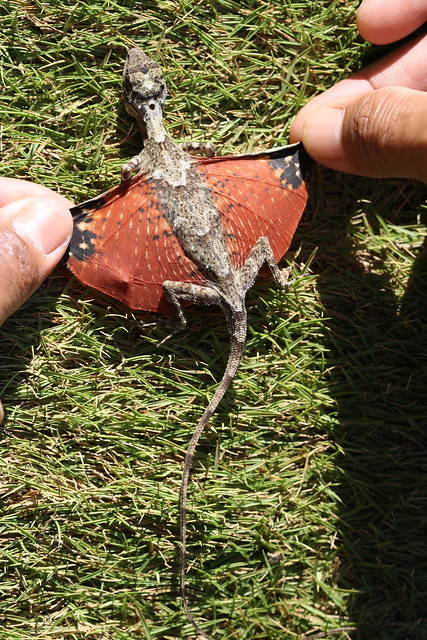
(Photo by Javier_M.)
Over the last couple of years, I've seen a particular image make its way around the Internet, popping up every now and then creating somewhat of a stir every time it resurfaces.
It all began when someone by the nickname of Biophilia_curiosus submitted this photo (depicted above) to Reddit. Apparently, the reptile pictured was caught on the island of Buton, just off the southeast peninsula of Sulawesi in Indonesia, where the submitter was involved in a herpetology study as part of Operation Wallacea. After several photos were taken, the lizard, which was a female that had descended from the trees to lay her eggs, was released.
This photograph was subsequently picked up by sites such as Neatorama, Treehugger, and the science blog Science Punk. I've seen this same photo shared on Twitter, with friends, knowing my interest in wildlife, pointing it out to me as well.
A lot of the reaction from the Internet has been that of amazement, with the inevitable comparisons with the dragon-like flying creatures in Avatar, or the gold-hoarding, princess-snatching, fire-breathing dragons of western mythology and fantasy. While it is a fascinating discovery, I'm not exactly very surprised, since this is after all, 'merely' a flying dragon (Draco spp.), and these small arboreal lizards of southern India and Southeast Asia have been known to the western world as far back as at least the mid-18th century.
Here are some images and descriptions from the 19th century. These gliding lizards most probably weren't that unfamiliar to the European naturalists and explorers who visited the forests of Southeast Asia.

FLYING DRAGONS OF MALAYSIA, Draco volans and fimbriatus. (From specimens brought home by M. Maurice Maindrou.)
(Image from Popular Science Monthly/Volume 36/April 1890/Dragons, Fabled and Real)
The only dragons with which science now concerns itself are the little saurians, which are classed by some naturalists with the acrodont iguanans and by others with the agamians, and of some of which we give representations.
There live in the forests of India, the Malay Archipelago, and the Philippine Islands, lizards, whose speckled dress and odd forms have long made them objects of interest to collectors. They live exclusively on insects, which they hunt with extreme agility of pursuit along the trunks and among the branches of trees. In whatever spot they may be hiding, their variegated liveries of gray and brown, speckled with black, yellow, or green, mask them effectively and cause them to pass unperceived in the cracks or among the inequalities of the bark. Squatting under this cover, they await the coming of some insect within reach of them ; or they may be seen running rapidly and suddenly covering considerable space, by a kind of flight, to place themselves upon another tree or fix themselves near a vine. Nature has been, in fact, pleased to facilitate the movements of these lively and graceful beings by an ingenious artifice. By the aid of their parachute, dragons can execute leaps in the air of considerable length, and pass from one tree to another as if by flying. But it must not be supposed that they can fly after the manner of birds. They can descend rapidly, describing a large parabola, sometimes almost a horizontal, but can not fly upward.
I have frequently observed these pretty little saurians in Java. The first time I saw one I succeeded in shooting him with a small- bored gun loaded with fine shot. When I picked my victim up I was somewhat surprised to find that I had a dragon ; for its jerky and irregular flight along a large tree had caused me to suppose that it was some kind of a grasshopper or moth, which I could not get in any other way than by shooting.
The dragons, as Cuvier says, fly by means of their ribs. Their first six pairs of false ribs, instead of being attached to the sternum, are drawn out and prolonged, so as to constitute the framework of a kind of umbrella, the covering of which is formed of a wide membrane making a fold in the skin of the flanks. This membrane is independent of the limbs. When at rest, it is folded up along each flank ; but it can be quickly un- folded and spread out in case of need. The name patagium has been given to it. The head and neck are ornamented with crests and dewlaps, often variegated with brilliantly defined colors ; and a long tail gives them a singular gait which is not without grace.
The harmless little flying lizards inhabit forests and garden trees ; and nothing is more amusing than to watch their manoeuvres, when, not aware that they are observed, they execute their gambols in the full flush of freedom. Running swiftly along the trees, stopping instantaneously, snapping up an insect or retiring disappointed after they have missed it; pursuing one another; inflating their dewlaps and depressing their crests when enraged, they fly away spasmodically to drop a few yards farther along, down upon another tree, along which they continue their evolutions. In some dragons the tympanum is visible, in others it is hidden by a fold of the skin. A special genus (Dranuncidus) has been constituted for the latter, while the former compose the genus Draco. This genus is represented by six species, of which three inhabit the island of Java ; one, recognizable by its vertical nostrils, is peculiar to continental India ; the fifth is native to the island of Timor ; and the sixth is found at Pulu Penang. The Dranunculus inhabits Amboyna in the Moluccas, Celebes, and the Philippine Islands.

THE KUBIN, Draco volans.
Sinensis delt. A. Cardon sc.
Published by W. Marsden, 1810.
(Image from The history of Sumatra, containing an account of the government, laws, customs, and manners of the native inhabitants with a description of the natural products and a relation of the ancient political state of that island)
The flying lizard, kubin, or chachak terbang (Draco volans), is about eight inches in its extreme length, and the membranes which constitute the wings are about two or three inches in extent. These do not connect with the fore and hind legs, as in the bat tribe, but are supported by an elongation of the alternate ribs, as pointed out by my friend Mr. Everard Home. They have flapped ears, and a singular kind of pouch or alphorges, under the jaws. In other respects they much resemble the chameleon in appearance. They do not take distant flights, but merely from tree to tree, or from one bough to another. The natives take them by springs fastened to the stems.

(from Dictionnaire encyclopédique Trousset)
Discovery News also had an article about the flying dragon photo shared by Biophilia_curiosus (who actually goes by the name of Javier Marin), one that focused more on the facts, rather than go on yet again about fabled mythical fire-breathing monsters. According to Jimmy A. McGuire, curator of Herpetology in the Museum of Vertebrate Zoology and associate professor in the Department of Integrative Biology, University of California, Berkeley, the lizard pictured could be a Beccari's flying dragon (Draco beccarii), a species native to eastern Sulawesi. However, without seeing the dewlap, which varies from species to species and is used as an identification feature. McGuire claimed that he couldn't be certain.
Javier Marin took more photos of this same lizard, but it was the one at the top, with the 'wings' spread open, that has proven to be the most widely circulated.



(Photos by Javier Marin)
The flying dragons consist of 41 species in the genus Draco, though that number is likely to go up as more new species are discovered and described. The genus is found in forests from India to southern China and Indochina, south through the Malay Peninsula, Sumatra, Java, Borneo, and Sulawesi, all the way to the islands of the Philippines, the Malukus, and Timor. Some species have a wide distribution across this range, while others are restricted to a few scattered islands. They are small lizards, ranging from 20 to 40 centimetres in total length.
Belonging to the family Agamidae, the flying dragons are commonly classified under the subfamily Draconinae, which are all small to medium-sized arboreal lizards found in the forests and woodlands of tropical Asia. The green-crested lizard (Bronchocela cristatella) and changeable lizard (Calotes versicolor), both of which are commonly encountered in Singapore, are also draconine lizards.
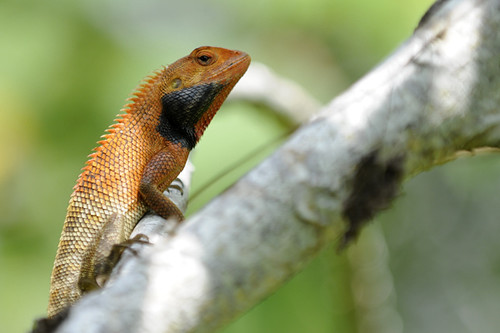
Changeable lizard;
(Photo by Jacqueline)
Where it comes to identification, a lot of confusion arises from the fact that only 1 species, the Javan flying dragon (Draco volans), is ever mentioned when the topic of flying dragons is brought up, whether it's in the technical literature, popular books, websites, or television documentaries. And so, you will also find a multitude of images of flying dragons from several different species, all wrongly identified as Draco volans.
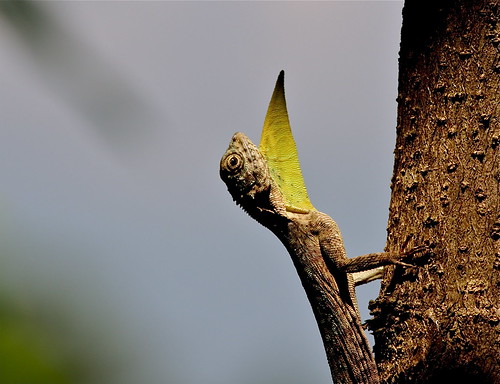
Javan flying dragon;
(Photo by Rucha Chitnis)
Some of this mess originates from older classification schemes, in which many species of flying dragon were formerly subsumed under Draco volans, and were only recently identified as separate species. Hence, you would think that this species is found across much of Thailand, Malaysia, Indonesia, and the Philippines. In fact, the 'true' Draco volans is native to Java and Bali.
The 'wings' of flying dragons are actually made out of elongated and flexible ribs, with flaps of skin stretched between the bony struts.

Drawing of flying dragon skeleton;
(Image from On The Genesis of Species, 1871)
By expanding this membrane (more properly called a patagium), a flying dragon is able to slow its descent, and glide from one tree to another. While airborne, the lizard is able to steer its flight path such that it makes the perfect landing on a tree trunk. This ability enables these gliders to avoid having to risk facing danger on the ground when trying to move between trees, a problem experienced by their non-gliding relatives. Flying dragons may glide from tree to tree for various reasons: in search of food or mates, to chase away rival males from their territories, or to make a quick escape from arboreal predators. Females are at their most vulnerable when they descend to the ground to lay and bury their eggs, otherwise flying dragons spend virtually all their lives in the trees.
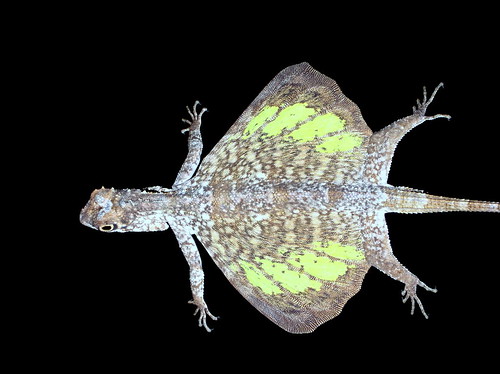
Two-spot flying dragon (Draco bimaculatus);
(Photo by smallislander)
The lizard pictured above probably wasn't actually gliding, but merely held such that its limbs and patagia were outstretched in a gliding position. Because they don't actually fly, flying dragons are also perhaps more accurately known as gliding lizards, a term which admittedly doesn't sound as romantic as 'flying dragon'.
The patagia are usually brightly-coloured, and like the dewlap, often serve to tell the different species apart.
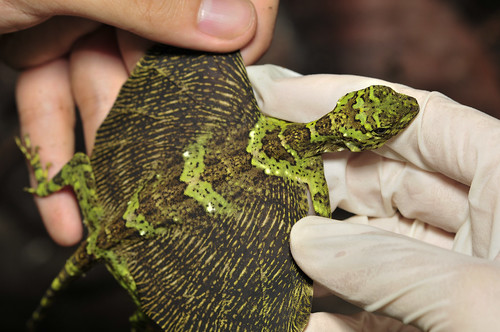
Great flying dragon (Draco maximus);
(Photo by Steven Wong (ATKR))
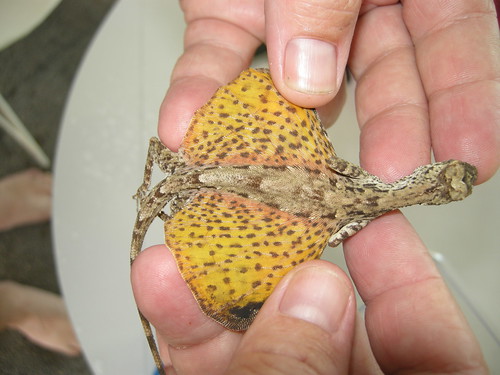
Philippine flying dragon (Draco spilopterus);
(Photo by Paul Bourdin)
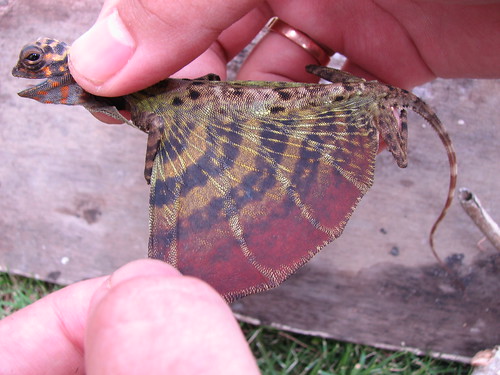
Dusky flying dragon (Draco obscurus);
(Photo by shobster)
Most of the time however, flying dragons are usually seen resting on tree trunks, with the patagia nicely folded away. Many species are extremely well-camouflaged against the tree bark.
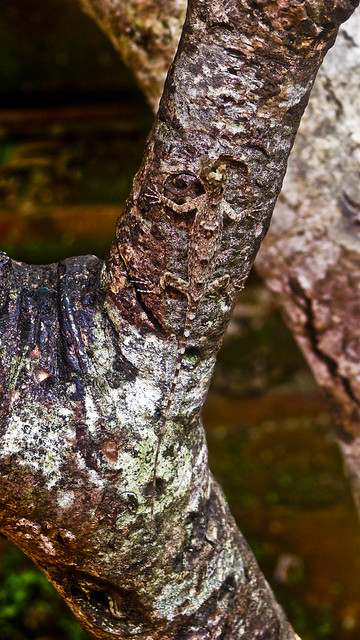
Javan flying dragon;
(Photo by georg.erber)

Southern flying dragon (Draco dussumieri);
(Photo by yathin)
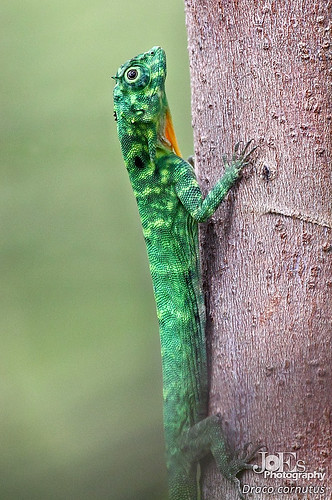
Horned flying dragon (Draco cornutus);
(Photo by junis_sp)
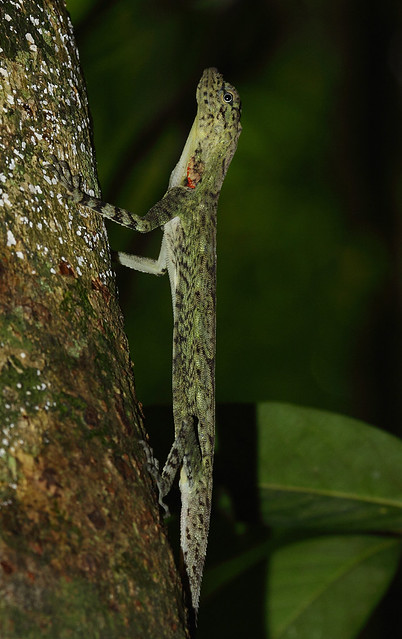
Blandford's flying dragon (Draco blandfordii);
(Photo by António A Gonçalves)
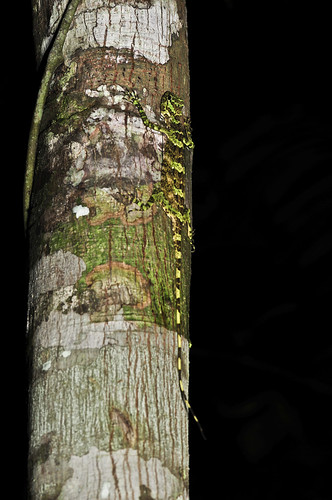
Great flying dragon;
(Photo by Steven Wong (ATKR))
Despite their excellent camouflage, the lizards often inadvertently give away their location when they flick their brightly-coloured gular flaps, which is present in both sexes, and used in display. All flying dragons also possess small throat lappets, which are supported by cartilage and might serve to generate additional lift, and enhance balance and stability.
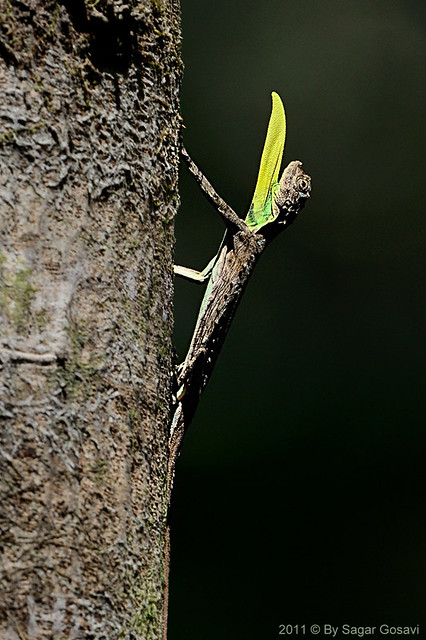
Southern flying dragon;
(Photo by The World Through My Eye)
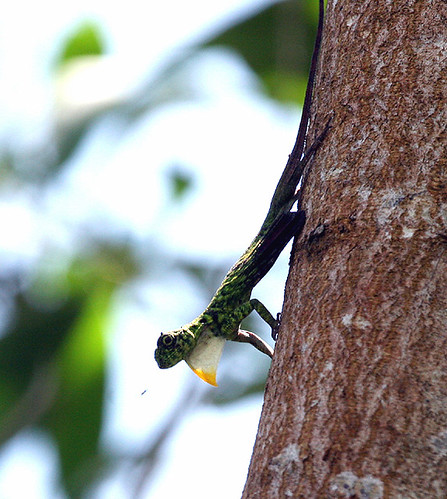
Horned flying dragon;
(Photo by sinooorita)

Unidentified flying dragon, possibly spotted flying dragon (Draco maculatus);
(Photo by António A Gonçalves)
Flying dragons have been recorded feeding mostly on ants, termites and other small insects, and are in turn preyed upon by many carnivores, such as birds and snakes.

Tiger shrike (Lanius tigrinus);
(Photo by Francis Yap)
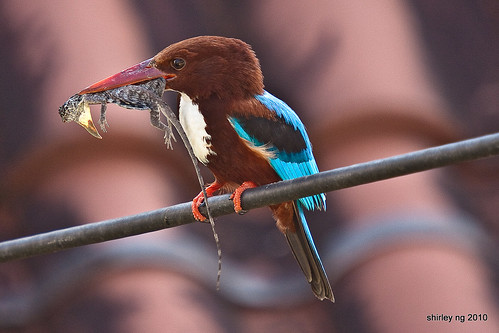
White-throated kingfisher (Halcyon smyrnensis);
(Photo by shirl6900)
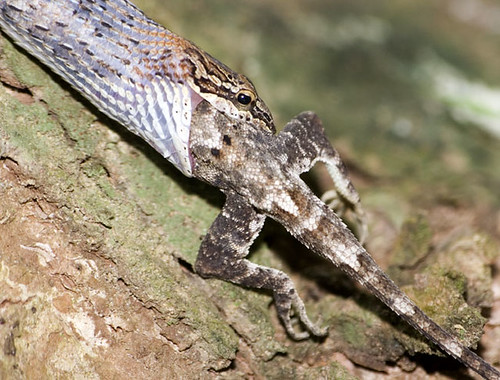
Keel-bellied whip snake (Dryophiops rubescens);
(Photo by Marcus)
Singapore is home to several species of flying dragon.

Common flying dragon (Draco sumatranus);
(Photo by dansengohsp)
The most widespread of all is the common flying dragon, a species that prefers the somewhat more open habitat found at the forest edge. As a result, it has adapted well to human activity, and can be found in many of our urban parks and gardens.

(Photo by kwokwai76)
For some of my friends and I, a trip to Chek Jawa usually includes a brief look at the tall rubber trees at Punai Hut, hoping to spot these small lizards high up on the tree trunks, basking in the afternoon sun and displaying to one another.
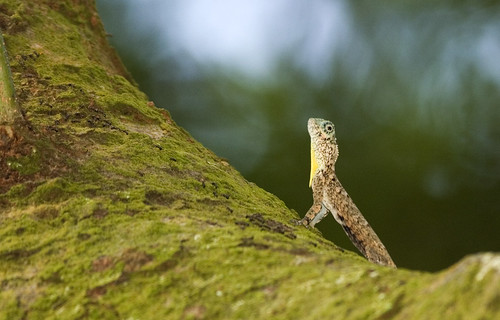
(Photo by Marcus)
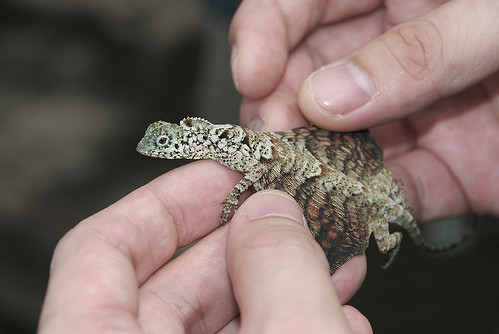
(Photo by Chee Kong)

Black-bearded flying dragon (Draco melanopogon);
(Photo by Lil Snoop)
The black-bearded flying dragon prefers mature forest, and is hence restricted to the secondary and primary rainforest found in the Central Nature Reserves.
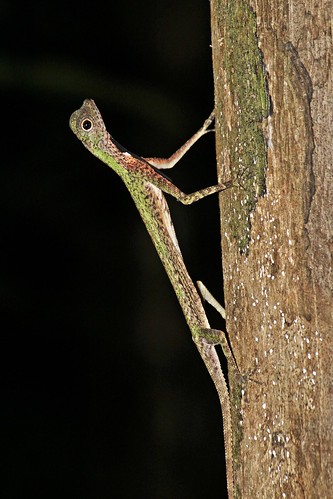
(Photo by hisno)
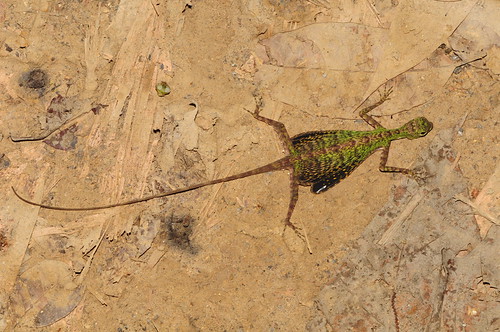
(Photo by Steven Wong (ATKR))
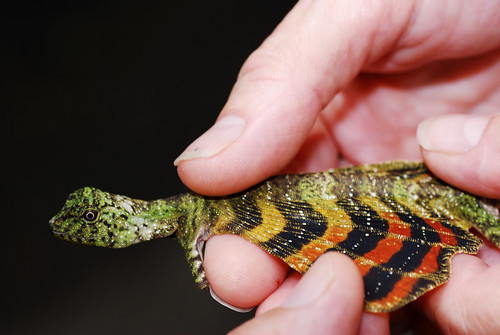
Five-banded gliding lizard (Draco quinquefasciatus);
(Photo by macro snake)
Similarly, the five-banded flying dragon is found in the same forest habitats as the black-bearded flying dragon. This species was first recorded in Singapore only in 2001. Indeed, even though our forest patches are small, they contain many surprises waiting to be discovered.
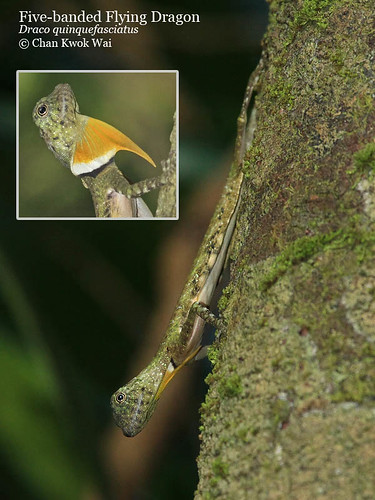
(Photo by kwokwai76)

Orange-bearded flying dragon (Draco abbreviatus), currently often confused with the fringed flying dragon (Draco fimbriatus);

Spotted flying dragon;
(Photos by Nick Baker, from Ecology Asia)
Some older references mention the presence of 2 more species of flying dragon in Singapore, the fringed flying dragon and the spotted flying dragon, although it is doubtful that they occur here.
As an aside, it seems that there is a great deal of confusion about the taxonomy of the fringed flying dragon. The orange-bearded flying dragon was once considered to belong to the same species, but it is likely to be a separate species altogether. Given that it is distributed further south in Peninsular Malaysia than the fringed flying dragon, it is possible that records of the fringed flying dragon in Singapore may actually be referred to the orange-bearded flying dragon instead.
Flying dragons are skittish animals, usually well-camouflaged, live high up in the trees, and easily elude capture. Many species also look quite similar, and are often conclusively identified only with close observation of the patagium and dewlap, which either requires excellent optics, or the luck to examine one up close.
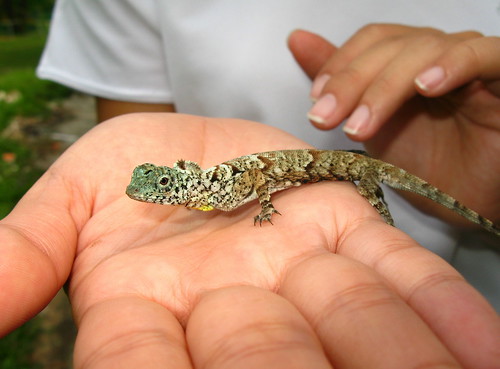
Common flying dragon;
(Photo by Helen)
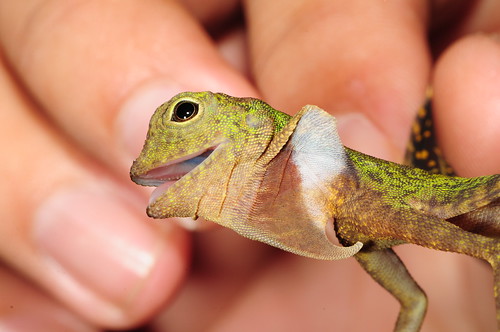
Black-bearded flying dragon;
(Photo by Steven Wong (ATKR))
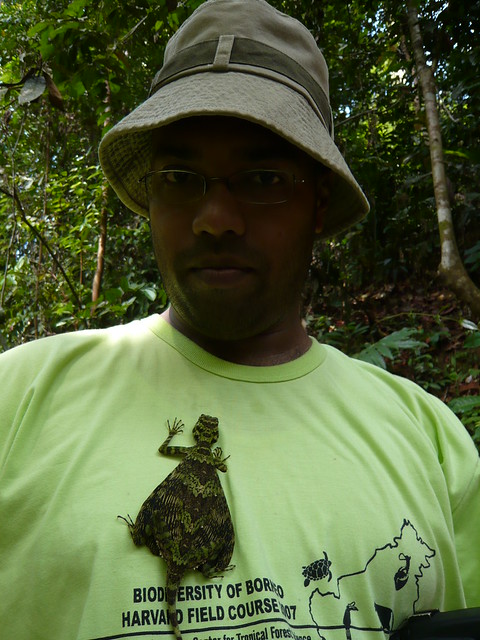
Great flying dragon;
(Photo by FBMagpie)
What's interesting about flying dragons is how several different species can live together in the same area, through what is known as niche partitioning. For instance, at least 10 different species of flying dragon are found in Peninsular Malaysia, and some of these species have overlapping ranges.

Common flying dragon;
(Photo by hisno)
This has a lot to do with the different gliding capabilities of each species, which is linked to size. To use an example, the small and lightweight black-bearded flying dragon has large patagia in relation to its body size, and is able to gain lift and glide at relatively low speeds. In contrast, the larger and heavier fringed flying dragon has proportionately smaller patagia, and needs to reach a higher velocity before attaining gliding speed. When jumping off trees, these larger lizards don't immediately start gliding, but instead go into a dive, with the patagia opening up only when the desired speed is achieved. As a result, the fringed flying dragon may have a preference for the crowns and upper branches of very tall trees, where it can safely carry out such dives and complete its glides, whereas the smaller black-bearded flying dragon, which is less constrained, may be found living on lower portions of the same trees. In this manner, 2 species of flying dragon are able to coexist without competing excessively over turf.
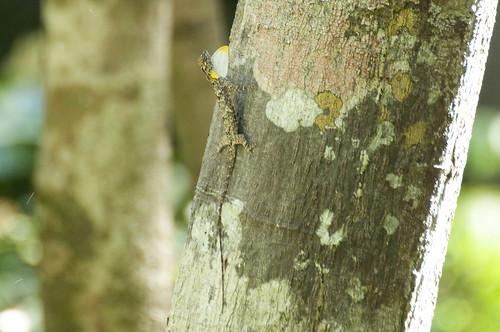
Fringed flying dragon;
(Photo by mamuin)
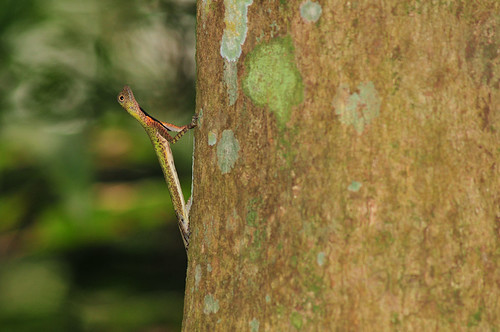
Black-bearded flying dragon;
(Photo by gingerbreadtot)
Differences are also seen in the specific type of habitat inhabited by the various species of flying dragon, with some preferring the more open woodlands and forest edges, while others live in dense patches of forest. A preference for highland or lowland areas also helps to minimise competition for resources.

Spotted flying dragon;
(Photo by johnaalex)
While the flying dragons are anatomically unique among the agamid lizards (and in fact, among extant vertebrates for that matter), gliding behaviour similar to that exhibited by flying dragons can be seen in other arboreal agamids not thought of as gliders. For instance, in the green-crested lizard, individuals have been recorded attempting to elude capture by leaping off branches, with the head, body, and tail held straight, all four limbs outstretched, and the ribs expanded and torso flattened. This allows the lizard to decrease the angle of its descent and glide for a short distance, presumably reducing the impact of the fall while escaping the threat. It is this behaviour, present in many smaller arboreal lizards, that has been taken to extremes by the flying dragons.

Green-crested lizard;
(Photo by lenkline)
As I mentioned previously in a post about gliding snakes (Chrysopelea spp.), it is fascinating that the forests of Southeast Asia are inhabited by a wide variety of animals with adaptations for gliding; besides flying dragons and gliding snakes, we also have tree frogs (Rhacophorus spp.) with extensive webbing between their toes that enable them to glide, geckos (Ptychozoon spp.) with webbed feet and flaps of skin along their bodies, as well as colugos (F. Cynocephalidae) and various flying squirrels (F. Sciuridae), which have membranes that stretch between the front and hind limbs. The flying dragons are the only extant group of tetrapods to have ribs modified into a wing-like structure for gliding. However, as unique as this adaptation may seem, the flying dragons are in fact not the only reptiles in Earth's history to take to the air in this manner.

(Photo by Zhao Chuang and Xing Lida, from New Scientist)
A prehistoric gliding lizard known as Xianglong zhaoi was described in 2007, based on a fossil excavated from the Early Cretaceous Yixian Formation of Liaoning in China. Although it is believed that the extant flying dragons are not directly descended from Xianglong, this ancient species is believed to be a member of the Iguania, a group of lizards that also includes the agamids. The only specimen known for this species so far was just 15.5 centimetres long, although it was apparently a juvenile, and would have grown larger.

Photo and drawing of Xianglong zhaoi fossil;
(Image from Li et al., 2007)

Kuehneosaurus latus;
(Reconstruction by Jim Robins)

This illustration is labelled as Kuehneosaurus, but the wing proportions are closer to that of Kuehneosuchus;
(Reconstruction by Steve Kirk, from Macmillan Illustrated Encyclopedia of Dinosaurs and Prehistoric Animals)
Other reptiles with similar adaptations for gliding have been recorded in the Late Triassic. Kuehneosaurus latus and Kuehneosuchus latissimus from England, and Icarosaurus siefkeri from New Jersey, were members of the Kuehneosauridae, a family that was somewhat more distantly related to true lizards like Draco and Xianglong. The kuehneosaurids are currently considered to belong to the Lepidosauromorpha, the group of reptiles that encompasses the squamates (lizards and snakes) and sphenodontians (tuatara).

While Icarosaurus was similar in size to modern day flying dragons (the small outline at the bottom represents a black-bearded flying dragon), Kuehneosuchus (left) and Kuehneosaurus (right) were much larger creatures, with body lengths of up to 70 centimeters;
(Drawing from Stein et al., 2008)

Skeleton of Kuehneosuchus latissimus;
(Drawing from Stein et al., 2008)
Despite its size, studies suggest that the large patagia of Kuehneosuchus would have made it a capable glider, whereas Kuehneosaurus, with its smaller patagia, may have done more parachuting than actual gliding. The same study noted that the 2 forms are so similar that they may merely represent different sexes of the same species; in this case, the evolution of the patagia may have also been influenced by sexual selection.

Reconstruction of Icarosaurus siefkeri
(Reconstruction by Julius Csotonyi)

Skeleton of Icarosaurus siefkeri;
(Drawing from Fraser et al., 2007)

Icarosaurus siefkeri fossil;
(Photo by John Merck, from Images of Nature)

(Reconstruction by Karen Carr, from Newswise)
Mecistotrachelos apeoros is another Late Triassic glider from Virginia that was described only in 2007, although it is unique in that it possesses such a long neck. Comparable in size to the extant flying dragon, with a body length of approximately 25 centimetres, its affinities are still unclear, but it's not so closely related to the lepidosauromorphs. Instead, this reptile could be affiliated with the Archosauromorpha, a group that includes the highly successful archosaurs (which are represented today by the crocodiles and birds).

CT scans and drawings of Mecistotrachelos apeoros fossils;
(Image from Fraser et al., 2007)


Reconstructions of Coelurosauravus jaekeli (above) and Rautiania alexandri (below);
(Drawings by NobuTamura)
An even more ancient group of gliding reptiles lived in the Late Permian, before the dinosaurs had evolved; Coelurosauravus jaekeli from Germany and England, Coelurosauravus elivensis from Madagascar, and Rautiania alexandri and Rautiania minichi from Russia were somewhat larger than the extant flying dragons, with an average length of 40 centimetres. They don't seem to belong to either one of the two major groups of reptiles, but are probably primitive diapsids, basal to the split between lepidosauromorphs and archosauromorphs. Presently, Coelurosauravus and Rautiania are known as the first tetrapods to ever take to the air. The bony rods supporting the 'wings' in these species are not elongated ribs, but rather, grow from the skin, creating a unique gliding apparatus unknown in any other tetrapod.

Skeleton of Coelurosauravus jaekeli;
(Drawing from Schaumberg et al., 2007)

Coelurosauravus jaekeli fossil;
(Photo from Geofinder)

Coelurosauravus jaekeli fossil;
(Photo from Frey et al., 1997)
Here's my attempt to present the relationships between these various gliding reptiles. Note that this simple diagram omits the vast diversity of other reptiles, both past and present.

In a recent study that looked at gliding in flying dragons, with extrapolations to similar prehistoric gliding reptiles, it was determined that Icarosaurus may have been the best glider of all, even better than the flying dragons, whereas the larger Kuehneosaurus and Coelurosauravus were probably less effective at gliding. It would be interesting for future studies to include Xianglong and Mecistotrachelos as well.

(Figure and caption from McGuire & Dudley, 2011)
We focus a lot on the 3 groups of vertebrates that have managed to achieve true flight (namely the pterosaurs, birds, and bats), but the biology of animals that glide is just as extraordinarily fascinating, and can have very useful applications in the development of technology that enables us to glide, whether it's with the use of aircraft, hang gliders, or special outfits.
According to the Chinese zodiac, this coming Lunar New Year will be the Year of the Dragon. While giant fire-breathing reptiles soaring through the sky are unfortunately very much the stuff of fantasy and imagination, it's no surprise that a small lizard with "wings" and aerial capabilities has managed to awe us, and is fittingly immortalised with the name Draco.